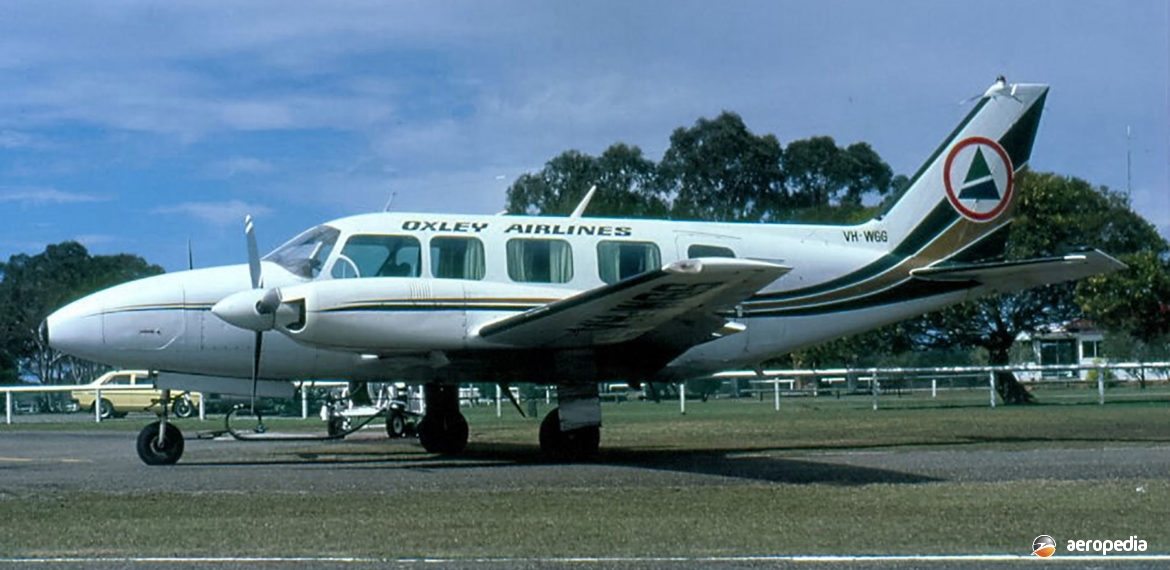Photograph:
Piper PA-31-350 Navajo Chieftain VH-WGG (c/n 31-7405175) at Port Macquarie, NSW in August 1987 (David C Eyre)
Country of origin:
United States of America
Description:
Business and executive aircraft / commuter airliner
Power Plant:
One 261 kw (350 hp) Avco Lycoming LTIO-540-J2BD [right] and one 261 kw(350 hp) Avco Lycoming TIO-540-J2BD [left] six-cylinder horizontally-opposed air-cooled engines
Specifications:
- Wingspan: 12.4 m (40 ft 8 in)
- Length: 10.55 m (34 ft 7½ in)
- Height: 3.96 m (13 ft)
- Wing area: 21.3 m² (229 sq ft)
- Max speed at 4,575 m (15,000 ft): 435 km/h (270 mph)
- Max cruising speed at 7,000 m (24,000 ft): 420 km/h (260 mph)
- Economical cruising speed at 6,100 m (20,000 ft): 396 km/h (246 mph)
- Initial rate of climb: 420 m/min (1,390 ft/min)
- Service ceiling: 8,290 m (27,200 ft)
- Range according to speed, 1,706 to 2,044 km: (1,060 to 1,270 miles)
- Fuel capacity: 727 litres (160 Imp gals)
- Empty weight: 1,866 kg (4,114 lb)
- Loaded weight: 3,175 kg (7,000 lb)
History:
In 1972 Piper added the PA-31-350 Navajo Chieftain to its range. The overall length over the PA-31-310 had been increased by 0.61 m (2 ft), thus allowing for a 20 per cent increase in overall cabin volume to provide accommodation for up to nine passengers plus the pilot in a commuter/charter aircraft role. In the cargo role over a tonne of payload could be carried, and a cargo loading door and cabin kit were offered as options. Cargo space was also available for 91 kg (200 lb) in the nose compartment; and for 68 kg (150 lb) in each engine nacelle. This model also had direct-drive turbo-charged engines of 261 kw (350 hp) in lieu of the 231 kw (310 hp) engines, and the propellers rotated in opposite directions to eliminate asymmetric torque.
After a few years of production the basic Navajo became known as the Turbo Navajo and, in 1970, the PA-31P Pressurised Navajo was added to the range. The prototype of this model was flown in March 1968 powered by 317 kw (425 hp) Lycoming TGIO-541-E1A geared, turbo-charged and fuel-injected engines. The production model, which had a pressurised cabin and normally seated six, was aimed mainly at the business and executive market. A total of 259 PA-31Ps was constructed.
Following the introduction of the Navajo Chieftain, the counter-rotating propellers were adopted and fitted on the PA-31-325 Turbo Navajo CR, which was powered by 242 kw (325 hp) Lycoming TIO-540-F2BD engines. Eventually the PA-31-350 became known as the Piper Chieftain, the Navajo name being dropped. The series was developed and other models built included the Mojave, a pressurised version of the Chieftain, and the T-1020 and T-1040 models, these being optimised for the small airliner role and powered by Pratt & Whitney PT-6 turbines. Total production of the Chieftain series was 1,825 aircraft.
The type has been used extensively for charter and third level airline work in this region since the first aircraft was imported in 1973 by the distributor, Ansett General Aviation, Hazelton Airlines using a fleet for some years on services in New South Wales until they were replaced by SAAB 340s. Other operators have included Air Link, Oxley Airlines, Royal Flying Doctor Service of Australia, Western Air Lines, Tasair, Country Connection, Flinders Island Airways, Airtex Aviation, Shepparton Airlines, Cape York Air Services, Southern Airlines, Phoenix Airways, State Government of Queensland, Eastern Pacific Airlines, Tamair, Cape York Air Services, Seaview Air, Arnhem Air, Westcoast Aviation, Skyway Airlines, Kendell Airlines, North Coast Airlines, and Air Tasmania, amongst others. In Australia in 2010 some 80 PA-31s, 111 PA-31-350s and two PA-31Ps were registered.
More than 20 examples have been registered in New Zealand. Operators in New Zealand have included Coast Air, Airwork, Mount Cook Airlines, Sunair Aviation, Air Charter Manawatu, Great Barrier Airlines, New Plymouth Aero Club, Mainland Air Services, Helicopter Services, Wairarapa Airlines, Goldfields Air, and Eagle Air. In New Zealand nine PA-31s, three PA-31-325s, eight PA-31-350s, and two PA-31Ts have been registered. In New Zealand one ZK-LTD (c/n 31-7300918) of Ashton Air Charter is a Navajo Panther, being fitted out with an executive class cabin, with TIO-540 engines driving four-blade Q-tipped propellers, and fitted winglets.
Examples have been used by a number of air forces around the world for light transport and communications duties, operators including the air forces of Finland, Argentina, Bolivia, Chile, Colombia, Dominica, Honduras, Israel, Kenya, Nigeria, Panama, Peru, Spain and Syria.

